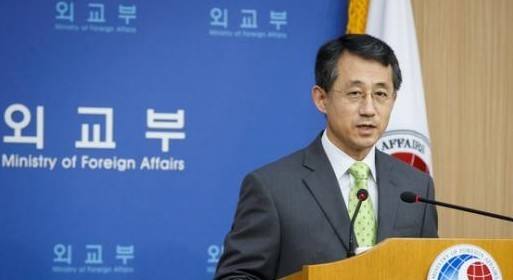(单词翻译:单击)
听力文本
Thousands of Korean Laborers Still Lost After WWII, Cold War End
Shin Yun-sun describes her life as a series of dead ends.
The South Korean has spent many of her 75 years questioning government officials, looking through records and searching burial grounds on a distant Russian island.
She is searching for evidence of a father she never met.
Shin wants to bring back the remains of her father for her 92-year-old mother, Baek Bong-rye. Japan's colonial government sent Shin's father away to do forced labor in September 1943. At the time, Baek was pregnant with Shin.
As the 75th anniversary of the end of World War II nears, the thousands of conscripted Korean men who disappeared on Russia's Sakhalin Island are a largely forgotten part of Japan's severe rule of the Korean Peninsula.
Historians say Japan forcibly moved around 30,000 Koreans as workers during the late 1930s and 1940s. They were sent to what was then called Karafuto, or the Japanese-occupied southern half of Sakhalin, near the northern Japanese island of Hokkaido. Most of the Korean laborers in Sakhalin came from the South.
When World War II ended, the Korean Peninsula was divided into a Soviet Union-backed north and U.S.-backed south. The 1950-53 Korean War came after, followed by the Cold War.
Soviet officials offered the Korean workers Soviet or North Korean citizenship beginning in the 1950s. But many chose to remain stateless in hopes of someday returning to South Korea.
Some of the Korean workers protested for a return to South Korea in 1976. Soviet officials answered by sending 40 of them and their families to North Korea.
South Korea and Russia established diplomatic relations in 1990 and about 4,000 Koreans have returned from Sakhalin in the years since. But for people like Shin, who lost contact with family members long ago, there has been little progress.
"The Soviet Union detained him, prevented him from going home and exploited his labor," Shin said about her father. "(The Russian government) should at least find and send back his remains."
Last year, Shin and other family members sought help from a United Nations group to find 25 Sakhalin Koreans. The U.N. group in June asked Russia's government to search for 10 of them first, said Ethan Hee-Seok Shin, a legal expert from the Seoul-based Transitional Justice Working Group. He has helped with the U.N. involvement.
Shin said that relatives only started feeling safe talking openly about their missing fathers in the last 20 years. This meant their effort got less attention than other cruel acts tied to Japan's colonial rule of Korea, said Bang Il-kwon, a scholar at Seoul's Hankuk University of Foreign Studies.
In 2011, a South Korean government group investigating colonial forced movement began working with Russia to identify and return the remains of the Koreans in Sakhalin who died before the 1990s.
South Korean researchers spent years examining the island's poorly kept burial areas, where stone or wooden markers were often missing, damaged or not clearly marked. In 2015, South Korean researchers reported that at least 5,000 graves belonged to Korean forced laborers.
But the efforts soon lost strength. South Korea's conservative government at the time refused to extend the group's mandate after 2015.
There has been little talk about restarting the activities under liberal President Moon Jae-in. His government has clashed with Japan over other wartime issues but also wants engagement with North Korea.
South Korea has said it hopes to reach a new agreement with Russia that would expand efforts to find and return the remains. However, Lee Sang-won, an official from South Korea's Ministry of the Interior and Safety, admits nothing has been agreed to yet.
Shin is critical of the slow progress.
She said, "Who knows how long it will be before my mother is gone, too?"
I'm Ashley Thompson.
重点解析
1.belong to 属于
Earls, princes, and kings belong to the nobility.
伯爵、亲王和国王属于贵族。
2.progress 进展
As the evening progressed, sadness turned to rage.
随着夜幕逐渐降临,悲伤变成了愤怒。
3.burial 葬礼
He can have a decent burial.
他会有个体面的葬礼。
4.expand 扩大
We have to expand the size of the image.
我们不得不放大图像的尺寸。
5.South Korea has said it hopes to reach a new agreement with Russia that would expand efforts to find and return the remains.
reach an agreement 达成协议
Companies have been stymied by the length of time it takes to reach an agreement
由于耗时过长,各公司一直未能达成协议。
We should reach an agreement on a common programme.
我们应该协定一个共同的纲领。
6.Shin Yun-sun describes her life as a series of dead ends.
a series of 一系列
The students have put forward a series of questions.
学生们提出了一系列问题。
A series of technical foul-ups delayed the launch of the new product.
一系列技术问题延误了新产品的上市。
参考译文
数万名二战时的朝鲜劳工下落不明
申尹善(Shin Yun-sun)形容自己的生活陷入无止尽的死胡同。
这位75岁的韩国人花了她一生中的大部分时间来询问政府官员,翻阅记录搜寻一处俄罗斯小岛上的墓地。
她寻找的是自己从未谋面的父亲的证据。
申尹善希望将父亲的遗骸交给92岁的母亲Baek Bong-rye。日本殖民政府于1943年9月将申尹善的父亲送去从事强迫劳动。当时Baek怀上了申尹善。
随着二战结束75周年纪念日的来临,这数万名应征入伍后在俄罗斯萨哈林岛上消失的韩国人,很大程度上是日本对朝鲜半岛严格统治中被遗忘的一部分。
历史学家表示,在上世纪三四十年代,日本强行让约3万名朝鲜劳工搬迁。他们被送到日本北海道附近当时所谓的卡拉富托,也就是日本占领的萨哈林岛的南半部。萨哈林岛上的大多数朝鲜劳工都来自韩国。

二战结束后,朝鲜半岛被划分为苏联支持的朝鲜和美国支持的韩国。随后在1950年到1953年期间发生了朝鲜战争,之后又发生了冷战。
上世纪50年代开始,苏联官员向这些朝鲜劳工提供苏联或朝鲜国籍。但是很多人选择保持无国籍状态,他们希望有一天能重返韩国。
1976年,一些朝鲜劳工发动示威要求返回韩国。作为回应,苏联官员将其中的40人及其家人送去朝鲜。
韩国和俄罗斯于1990年建立外交关系。此后的几年里,大约有4000名朝鲜人从萨哈林岛返回韩国。但是对于像申尹善这样很早就与家人失联的人来说,一直没有消息。
申尹善谈到父亲时表示:“苏联扣留了他,不让他回家,并剥削他的劳动。俄罗斯政府至少应该找到他的遗骸并送回来。”
去年,申尹善和其他家庭寻求联合国组织的帮助以找到25名在萨哈林岛的朝鲜人。总部设在首尔的过渡司法工作小组的法律专家Ethan Hee-Seok Shin表示,这家联合国组织于6月份要求俄罗斯政府首先寻找其中的10人。他协助了联合国的这次介入。
申尹善表示,最近20年,亲属们才敢在人前谈论失踪的父亲。首尔韩国外国语大学的学者Bang Il-kwon表示,这意味着他们的努力没有受到其它跟日本对朝鲜殖民统治残酷行为那么多的关注。
2011年,韩国政府一家调查殖民地强迫迁移的机构开始与俄罗斯合作,确认并归还于上世纪90年代之前去世的萨哈林岛朝鲜人的遗体。
韩国研究人员花了数年时间调查了该岛年久失修的墓地,那里的石制或木制的标记经常丢失、损坏或模糊不清。2015年,韩国研究人员报告称,至少有5000座坟墓属于韩国劳工。
但是这些措施很快失效。2015年之后,当时的韩国保守派政府拒绝延长该组织的授权。
自由派总统文在寅统治下的政府也很少谈到重启这一活动。该政府与日本在战时问题上发生了冲突,但是也希望与朝鲜接触。
韩国称希望与俄罗斯达成一项新协议,以扩大搜寻和归还遗骸的工作。然而,韩国内政与安全部官员Lee Sang-won承认目前尚未达成任何协议。
申尹善对这一缓慢的进展表示批评。
她说:“谁知道我母亲还能在世多久呢。”
阿什利·汤普森为您播报。
译文为可可英语翻译,未经授权请勿转载!


